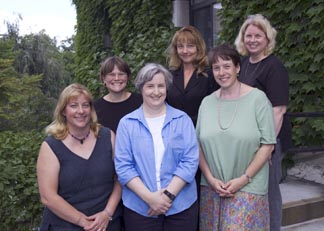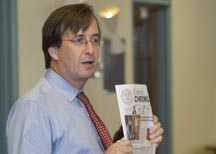Name change for Cornell communicators group reflects what members do
By Linda Myers

One of the oldest and largest ongoing professional groups on campus has a new name.
The Cornell Editors Group, whose members have been lunching and learning on the first Thursday of every month for about 23 years, is now communicators@cornell (yes, the lowercase letters and the @ sign are intentional and got a stamp of approval from some of the strictest editors on campus before being adopted this September).
The name change was needed to better reflect the membership, which, in addition to editors of all stripes, includes writers, graphic designers, production coordinators, Web workers, photographers and anyone else involved in producing the enormous quantity of words and images that broadcast Cornell's story to the world in print and online, said Kathleen Rourke.
In addition to her day job as managing editor of the Cornell Law Forum and publications coordinator at the Law School, Rourke is an active member of EGAD!, the seven-person committee that plans the communicators@cornell monthly luncheon programs. The acronym stands for Editors Group Administrative Directors. The exclamation point makes fun of members' distress at having to come up with something new to entertain and inform colleagues at each meeting.
Informality and a light touch are part of the charm of communicators@cornell and are evident in this month's e-mail inviting Cornell communicators to the next luncheon program, in October. Informality and a light touch are part of the charm of communicators@cornell and are evident in this month's e-mail inviting Cornell communicators to the next luncheon program, in October.
"The communicators group is a wonderful place to network and learn something new," said Linda Haylor-Mikula, art director of the Office of Publications and Marketing, who has presented on award-winning designs at luncheon meetings.
"Several presentations have been valuable to me in terms of getting plugged into what's going on with Cornell's marketing strategy, including learning about the considerable thought and effort that went into the design of the university's new logo and the Cornell home page," said Janice Endresen, editor of Cornell Enterprise at the Johnson Graduate School of Management.

But the meetings also can be about learning that's strictly for fun, such as visiting lecturer John Chiment's talk on where to find fossils in stones at Cornell; local cook and illustrator Lisa Cowden's, on how she became a cookbook author; and children's book author David Kirk's, on his Miss Spider series. And sometimes members, who have active lives beyond their jobs, read from their own writing, much of it published professionally: historical novels, murder mysteries, personal essays, poems and other literary works.
In addition, the luncheons are an excellent place to advertise job openings, learn about skilled freelancers new to town and stay in touch with the lives of colleagues. Many members of the group tend to continue coming to gatherings long after they retire.
Trudie Calvert, an editor at the former Media Services, now Publications and Marketing, who died in 2000, managed the Editors Group's business single-handedly for well over a decade, sharing only the planning of programs with a handful of volunteers. "We don't know how Trudie managed to do it all," said Rourke.
After Calvert became too ill to work, EGAD! was formed to take over her Editors Group tasks, but she managed to participate in a planning meeting held shortly before her death, at Hospicare, the Ithaca hospice.
In addition to Rourke, Morse and Doolittle, EGAD! members currently include Leslie Intemann, technical communicator, and Beth Goelzer Lyons, marketing analyst, CIT Marketing; Deena Rambaum, graphic designer, Publications and Marketing; and Kelly Strickland, graphics assistant, Chemistry and Chemical Biology. To find out more about upcoming communicators@cornell luncheon programs, contact Rourke at ker8@cornell.edu or visit this Web site: http://web.cornell.edu/communicators/.
"Dear Colleagues," writes EGAD! member Ann Morse, media manager, Continuing Education and Summer Sessions, "If you think you've ever had trouble with printers, wait until you hear about James Joyce's experiences!" The letter goes on to announce a group tour of the exhibit, "From Dublin to Ithaca: Cornell's James Joyce Collection" at the Carl A. Kroch Library.
The group, with a mailing list of about 165, is about 80 percent women. Usually meetings take place at 401 Warren Hall and a handful of other rent-free venues on campus large enough to hold the 50 to 75 communicators who are likely to attend. The meal is provided by an array of local caterers and restaurants. The fee for lunch, which departments often pick up, is the only one associated with being a member of the group, which does not charge dues.
"[Attending meetings] really enhances our coverage of Cornell," said Jim Roberts, editor of Cornell Alumni Magazine. "And the food is pretty good."
The programs are "the best and cheapest professional development available," said Jeanette Knapp, a former senior writer at Alumni Affairs and Development Communications and an EGAD! member emerita.
"I enjoy the feeling of connectedness, energy and creativity that comes from this informal, grassroots group of communicators," said Nancy Doolittle, director of Human Resource Communication Services and an EGAD! member. "Not only do you get a sense of the latest developments and challenges in the communications field, but you also get a sense of what is happening in other colleges and units."
Programs often help Cornell communicators learn more about areas relevant to their jobs, such as postal rules and regulations for bulk mail, copyright law and readership surveys. They also are a way for upper-level administrators to answer questions about policy and new initiatives. Recent speakers have been Tommy Bruce, vice president for university communications, Mary George Opperman, vice president for human resources, and Tracy Mitrano, director of information technology policy.
Media Contact
Get Cornell news delivered right to your inbox.
Subscribe